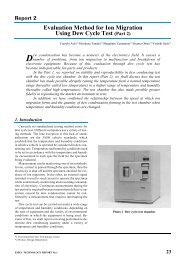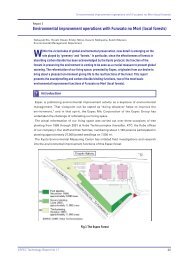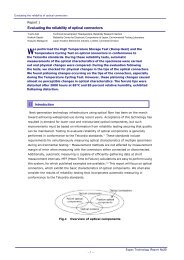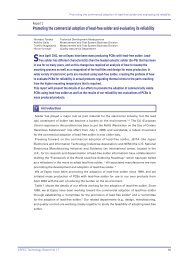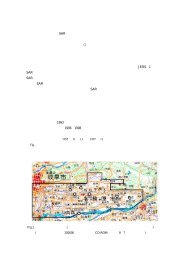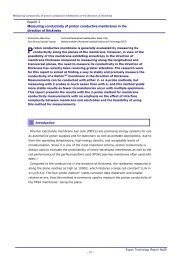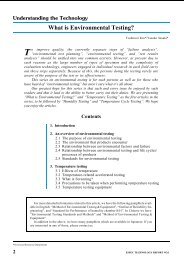download
download
download
You also want an ePaper? Increase the reach of your titles
YUMPU automatically turns print PDFs into web optimized ePapers that Google loves.
Report 2<br />
Explanation of International Standard IEC 68-2-66<br />
Environmental testing – Part 2:Test methods – Test Cx: Damp heat, steady state<br />
(unsaturated pressurized vapour)<br />
Toshio Yamamoto*<br />
This standard was established and published in June, 1994. Deliberations on the<br />
contents were inaugurated by working group 4 of subcommittee 50B, and about<br />
5 years have passed since concrete activities were begun.<br />
The Japanese Industrial Standard, JIS, conforms to the ISO and the IEC. This<br />
standard is soon to be adopted by JIS, and it is expected to be put to practical application<br />
in business contracts as one method of environmental testing in such areas as electrical<br />
and electronics parts and products.<br />
1. Introduction<br />
As a formal member of WG4, Tabai Espec was<br />
deeply involved in creating the original draft together<br />
with members from other countries. Tabai Espec’s contribution<br />
was based on its results of developing testing<br />
equipment using test conditions and developing and improving<br />
test software. Most of the essential points and<br />
the details were proposed by the Japanese participants.<br />
The IEC 68-2-66 test conditions have been formally<br />
published by IEC and have been internationally recognized.<br />
The Highly Accelerated temperature and humidity<br />
Stress Test (HAST) chamber of Tabai Espec has also<br />
gained international standing.<br />
Table 1 Composition of standards<br />
Main article Attached document<br />
1. Appropriate Range A. Steam Pressure Table †<br />
2. Summary of Test<br />
B. Physical Meaning of<br />
the Test<br />
3. Test Equipment<br />
C. Definition of Humidity<br />
4. Test Severity<br />
D. Test Equipment and<br />
Handling<br />
5. Initial Measurement<br />
6. Test<br />
7. Intermediate measurement<br />
8. Recovery<br />
9. Final Measurement<br />
10. Information to be given in the relevant specification<br />
sheets<br />
† Attached document (Annex) A, the Steam Pressure Table, forms a<br />
portion of the main article.<br />
* Environmental Test Technology Center<br />
2. Summary of Test Method<br />
2-1 Appropriate Range<br />
· The subjects of testing are small electrical and electronics<br />
devices, mainly non-hermetically sealed devices,<br />
particularly those sealed in plastic.<br />
· Durability against degradation from temperature and<br />
humidity is evaluated using acceleration methods.<br />
· External effects such as corrosion and distortion of<br />
test specimens are not considered in this test.<br />
As noted above, the reasons for limiting the type of<br />
specimens that are subject to evaluation are as follows.<br />
Materials such as plastics can be more economically<br />
sealed than metals and ceramics, which require more<br />
complicated sealing techniques. However, plastics are<br />
extremely porous in the micro range, meaning they are<br />
permeable and so extremely poor at sealing out moisture.<br />
Despite this, most electric and electronic parts are<br />
currently sealed in plastic, and plastics are used in sealing<br />
extremely vital functional parts such as IC.<br />
We would like to make very clear that the subject of<br />
evaluation is the sealed internal section of the specimen,<br />
and that distortion of the external section is not considered.<br />
18 ESPEC TECHNOLOGY REPORT No.2



